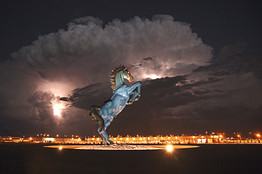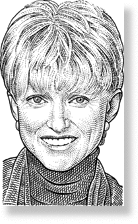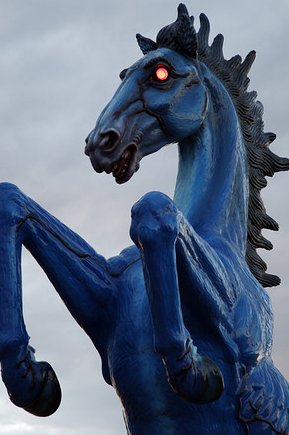The mustang rears on splayed hind legs -- his nostrils flaring, his eyes glowing red, his taut body a slick, sweaty sheen of blue. Anatomically correct -- eye-poppingly so -- the 32-foot-tall fiberglass sculpture makes quite a statement at the gateway to Denver International Airport.
But that begs the question: What kind of statement, exactly?
"It looks like it's possessed," says Denver resident Samantha Horoschak. "I have a huge fear of flying anyway, and to be greeted at the airport by a demon horse -- it's not a soothing experience."
Many people here agree, calling the muscular steed a terrifying welcome to the Mile High City.
Now a local developer, Rachel Hultin, has launched a campaign to get the wild horse moved so it isn't the first thing visitors to Denver see. In the past month, Ms. Hultin has signed up about 7,600 supporters on her Facebook page, Bye Bye Blue Mustang. This week she dropped off 200 protest haiku at the mayor's office. (Sample verse: Because of this thing / People think they are in hell / Instead of Denver.)
But uprooting public art turns out to be quite tricky. Especially a piece as emotionally freighted -- and as critically acclaimed -- as Mustang.
The Denver airport commissioned the sculpture in 1992 from Luis Jimenez, a widely honored artist known for melding Chicano themes and Western history in exuberant sculpture. The airport is full of public art, most of it much tamer -- silver pinwheels in a tram tunnel, a fleet of sky-colored paper airplanes. The mustang was to be a symbol of Denver and the West.
Mr. Jimenez was killed working on the sculpture. In 2006, while he was hoisting pieces of the mustang for final assembly in his New Mexico studio, the horse's massive torso swung out of control and crushed the 65-year-old artist. Mr. Jimenez's widow and children helped finish the sculpture, and it was installed last February at the airport, at a cost to the city of $650,000.
'Built With Love'
"You look at the piece and you just know it was built with love," says the artist's widow, Susan Jimenez.
The jabs flung at the mustang by amateur critics -- who have described it as "mean," "scary," and "like the Ringwraith horse from 'Lord of the Rings' " -- perplex Ms. Jimenez. She says she's disappointed that people don't seem to grasp her husband's intent.
The eyes are light-emitting diodes, which burn red like taillights. They are an homage to Mr. Jimenez's father, who ran a neon-sign studio in El Paso, Texas, she says. The well-articulated body, laced with bulging black veins, pays tribute to a mighty breed that Mr. Jimenez saw as a symbol of freedom, strength and the American West.
When she looks at the mustang, framed against the wide prairie sky, Ms. Jimenez thinks of her husband petting his beloved appaloosa, Blackjack. "I know he didn't mean anything demonic by it," she said. "I'm sorry if people are afraid of ribs on a horse."
Mr. Jimenez's sculptures grace museums and public squares all over the country: rugged Mexican cowboys, or vaqueros; dancing señoritas in ruffled skirts; a huge purple ox; weary migrants. His "Southwest Pieta" -- which depicts a Native American bent over the body of a woman with flowing hair -- was designated a national treasure during the Clinton administration.
Awash in carnival colors, the sculptures may look like they've popped out of a comic book, but they're imbued with deep emotion and stamped with the history of a people and a culture, says Betsy Broun, director of the Smithsonian American Art Museum in Washington.
"His is not a quiet, meditative, reflective art," Ms. Broun says. "It's an art that says, 'This is important!' and reaches out to grab your attention."
Firm Support
Most cities have had controversies over public art, but Ms. Broun says she's shocked to hear that anyone opposes the Denver Mustang. "It's fabulous," she says firmly.
Many Denver citizens beg to differ.
"When they unwrapped it, I was just horrified," says Dena McClung, who watched from the airport tower, where she worked as an air-traffic controller until her recent retirement. "It makes me feel like I'm looking at something out of a science-fiction movie."
A list of nicknames suggested last year by readers of the Rocky Mountain News ran from Beelzebub's Blue Bay to Satan's Stallion. The protest haiku drew on similar themes, as in this one:
Ugly devil horse"It's disturbing," says Nancy Harris, a Denver painter. "As an artist myself, I totally respect the artist's vision. But I don't think it's representative of the Denver community."
horrifies the traveler
shames our fair city
Mr. Jimenez's stallions have sparked uproars before. A much smaller (and more muted) version of the blue mustang "caused quite a stir" when installed at the University of Oklahoma's art museum in 1997, says Susan Baley, a curator. "It just didn't fit peoples' definition of public sculpture," she says.
Mr. Jimenez appeared on the campus to respond to the complaints in person, drawing an audience of 700, a record crowd for the art museum. The sculptor's charisma, passion and humor won over many of his detractors, Ms. Baley says. (It didn't hurt, either, that the museum moved the sculpture to a less-prominent location.)
"It's become a local landmark," Ms. Baley says. "People have adjusted."
Denver officials are hoping for a similar response. City rules require any public-art installation to remain in place for at least five years, to honor the artist's intent and give the work a chance to grow on the public.
Resigned to looking at it for at least the next few years, Ms. Hultin, the leader of the anti-Mustang campaign, now plans to launch a public-education effort to demystify the sculpture.
Art Workshops
She envisions brochures in the Denver airport, articles in in-flight magazines, and plaques describing the artist's style and intent mounted along concourse walls. She'd even like to hold workshops for taxi and shuttle-bus drivers so they can respond to startled comments from visitors coming across the mustang for the first time.
Her goal: Instead of being scared, "when people see it, they'll be like, 'Oh, that's interesting,' " she says.
Erin Trapp, director of the Denver Office of Cultural Affairs, hopes for more enthusiasm than that. She says the city has logged plenty of nasty calls about the statue, but also many glowing comments from fans who find it clever and powerful. The passion on both sides thrills her, and she hopes it doesn't fade.
"The point of art is not just to make beautiful public spaces but also to engage people," Ms. Trapp says. "That's when we know we've had a success -- when people care."






Reader Comments
to our Newsletter